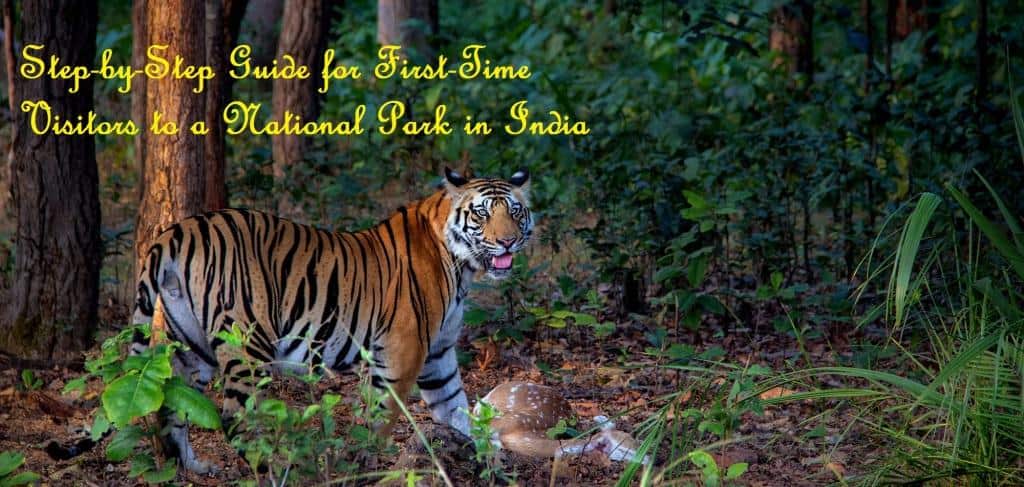Research and Plan Indian National Park
- Before booking a safari at any India National Park, it’s essential to conduct thorough research and plan your trip accordingly. Consider the following:
- Best Time to Visit: National Park has different safari seasons, so research when the best time to visit is for wildlife sightings and weather conditions.
- Types of Safaris: The Park offers various safari options, such as Jeep safaris and canter safari sharing safaris. Learn about each option and decide which one suits your preferences.
- Accommodation: Look into accommodation options inside or near the park. Decide whether you want to stay in luxury resorts, forest lodges, or budget-friendly guesthouses.
- Permits and Regulations: Understand the permit booking process and any specific regulations related to safari activities.
- Transportation: Plan your transportation to and from National Park. The nearest airports and train stations should be considered.
- Wildlife Guidebooks and Websites: Refer to guidebooks and online resources that provide detailed information about the flora and fauna found in National Park. This will help you understand what to expect and appreciate the biodiversity during your safari.
- Budget Planning: Create a budget for your entire trip, including safari costs, accommodation, transportation, meals, and any additional activities you plan to do.
- Duration of Stay: Decide how many days you wish to spend in the park. Longer stays increase your chances of sighting wildlife and experiencing more safaris.
Choose a Safari Zone
Indian National Park is divided into multiple safari zones, each offering different landscapes and wildlife opportunities. Some zones are known for tiger sightings, while others have diverse birdlife or unique terrain. Research the zones and select the one that aligns with your interests.
- Discuss with Experts: Seek advice from experienced wildlife enthusiasts, travel agents, or tour operators who are familiar with Indian National Park. They can offer valuable insights and recommendations on the best safari zones based on your interests.
- Zones for Photography: If you are an avid photographer, research which zones offer better opportunities for wildlife photography and plan accordingly.
Planning Your Safari: How to Make Reservations
Once you have chosen your preferred safari zone and the date of your visit, it’s time to make the safari reservations. Depending on the regulations, permits may be available online or through authorized agents. Ensure you book well in advance, especially during peak seasons, to secure your spot.
- Online Booking Platforms: Check the official website of Indian National Park or authorized booking portals for availability and permits. Some websites allow you to book specific zones and preferred safari timings.
- Booking via Tour Operators: If you prefer a hassle-free experience, consider booking your safari through reputed tour operators who can handle permits and other logistics.
- Safari Timings: Indian National Park offers both morning and evening safari sessions. Check the timings for each session and choose the one that suits your preferences and availability.
- Safari Permits: Obtain the necessary permits for the specific safari zones you wish to visit. These permits may have limited availability, so book them early to secure your preferred dates.
- Gypsy/Jeep Sharing: If you are traveling solo or as a small group, consider sharing a Gypsy (open-air safari vehicle) with others to reduce costs. Many tour operators can help you find fellow travelers to share the safari vehicle.
- Private Safaris: If you prefer a more exclusive experience, you can opt for a private Gypsy safari, where you have the entire vehicle for yourself or your group.
- Safari Zones and Buffer Zones: Apart from the core safari zones, Indian National Park also has buffer zones where you can experience nature walks and explore the outskirts of the park. Inquire about these options while making your reservations.
- Park Timings and Seasonal Variations: The park timings, safari schedules, and accessibility to certain zones may vary depending on the season. Research the best time to visit and familiarize yourself with any changes in timings.
- Limited Safari Vehicles: The number of safari vehicles allowed inside the park at a given time is limited. It is advisable to book early, especially if you have a specific date or zone in mind.
- Safari Duration: Jeep safaris typically last for about 3 to 4 hours, Plan your schedule accordingly and enjoy the immersive experience.
- Guide Selection: Some safari booking platforms allow you to choose your safari guide in advance. Selecting an experienced and knowledgeable guide can significantly enhance your wildlife spotting experience.
Your Wilderness Abode: Accommodation Choices for the Journey
Next, book your accommodation at or near Indian National Park. Depending on your budget and preferences, choose from the available options and make reservations accordingly. Staying inside the park can offer a more immersive experience, but there are also good lodging options outside the park boundaries.
- Early Bookings: Accommodation inside or near the park tends to fill up quickly, especially during peak seasons. Book your lodging well in advance to avoid any last-minute disappointments.
- Reviews and Ratings: Read reviews and check the ratings of the accommodations to ensure they meet your expectations in terms of service and comfort.
- Proximity to Safari Zones: If tiger spotting is your primary goal, consider staying in accommodations closer to the safari zones known for frequent tiger sightings.
- In-house Naturalists: Some lodges and resorts have in-house naturalists who conduct nature walks and share valuable insights about the park’s ecology. This can add a learning dimension to your trip.
- All-inclusive Packages: Some lodges offer all-inclusive packages that cover accommodation, meals, and safari bookings. These packages can be convenient and often provide a more seamless experience.
- Special Accommodations: If you have specific accommodation preferences, such as eco-friendly lodges or luxurious tented camps, research the available options and book accordingly.
- Local Cultural Experiences: Some lodges and resorts offer cultural performances and interactions with local communities. Consider adding these experiences to your itinerary to get a glimpse of the region’s traditions and customs.
- Check-In/Check-Out Times: Be aware of the check-in and check-out times of your accommodation to align your travel plans with safari schedules.
- Safari Package Inclusions: If you opt for all-inclusive safari packages, double-check what is included, such as meals, guided nature walks, and additional activities.
- Cancellation Policies: Understand the lodge’s cancellation policies in case of any unforeseen changes to your travel plans.
Plan Your Transportation: Getting to the National Park
Plan your transportation to Indian National Park, taking into account the nearest airport or train station. If you’re flying in, book your flights in advance. Arrange for local transportation options like taxis or rental cars to get to the park and move around the area.
- Local Guide and Drivers: If you’re not familiar with the area, hiring a local guide and driver can be beneficial. They can assist you during your stay and provide valuable information about the park and its wildlife.
- Public Transportation Options: If you’re on a budget, research the availability of public transportation options to reach the nearest town or village to Indian National Park.
- Park Entry Gates: Indian National Park has multiple entry gates. Confirm the entry gate nearest to your accommodation and plan your transportation accordingly.
- Local Transport Options: If you are not driving to the park, arrange for local transportation from your accommodation to the park’s entry gate for the safari.
- Timing Considerations: Account for travel time from your accommodation to the park’s entry gate, especially for early morning safaris, to ensure you reach on time.
- Road Conditions: Be prepared for rough and bumpy roads, especially during the safari inside the park. Ensure your transportation is suitable for such terrains.
- Distance to Nearby Attractions: Research other nearby attractions or points of interest you may want to visit during your stay and plan your transportation accordingly.
- Shared Cabs: If you are on a budget, shared cabs from nearby towns to the park’s entry gate can be a cost-effective mode of transportation.
Packing for a National Park Safari: Must-Have Items for Nature Enthusiasts
Before your safari adventure, pack wisely for your trip. Don’t forget essentials such as comfortable clothing, sturdy footwear, insect repellent, sunscreen, binoculars, a camera, and any required medications. Check the weather forecast to pack accordingly.
- Binoculars and Field Guides: Bring binoculars to enhance your wildlife viewing experience. Field guides can also help you identify different species of animals and birds.
- Medical Kit: Carry a basic medical kit with essentials like band-aids, pain relievers, antiseptic creams, and any personal medications you might need.
- Clothing: Dress in earthy tones to blend with the surroundings and avoid bright colors that might startle the wildlife. Layered clothing is ideal as the temperatures can vary throughout the day.
- Water and Snacks: Carry an adequate supply of water and some snacks for the safari. Remember to carry reusable water bottles to minimize plastic waste.
- Camera Equipment: If you’re interested in Tiger Photography India, bring appropriate camera equipment, including telephoto lenses for capturing wildlife from a distance.
- Power Banks: Keep power banks handy to charge your electronic devices, as there might be limited access to charging points during safaris.
- Light Snacks and Water: While some lodges provide packed breakfasts for early morning safaris, carrying some light snacks and extra water can be useful during the safari.
- Clothing for Different Seasons: Indian National Park experiences varying temperatures throughout the year. Pack accordingly, with warm clothing during winter and light, breathable fabrics during summer.
- Follow Safety Guidelines
- During the safari, always follow the safety guidelines provided by the park authorities and your safari guide. Respect the wildlife and their natural habitat by maintaining a safe distance from the animals and not disturbing them in any way.
- Respect Nature: Adhere to the park’s rules and regulations. Do not litter, feed the animals, or disturb their natural behavior in any way.
- Listen to Guides: Pay attention to the instructions given by your safari guide. They are experienced in navigating the park and will ensure your safety.
- Stay Inside the Vehicle: During the safari, ensure that you remain seated inside the Gypsy/Jeep at all times and avoid standing up or leaning out of the vehicle.
- No Flash Photography: Avoid using flash photography during the safari, as it can disturb and disorient the animals.
- Respect Wildlife Distances: Maintain a safe and respectful distance from the animals to ensure their comfort and minimize any potential risks.
- Emergency Contacts: Save emergency contact numbers of the lodge/resort, local authorities, and your safari guide in case of any unforeseen situations.
- Medical Assistance: Inform your safari guide or lodge staff about any medical conditions or allergies you have, so they can provide appropriate assistance if needed.
- Wildlife Viewing Etiquette: Understand and respect the park’s guidelines for wildlife viewing, such as maintaining silence and not disturbing the animals.
Enjoy the Safari at Indian National Park
Finally, relax, enjoy, and immerse yourself in the breathtaking wildlife and natural beauty of Indian National Park. Keep your camera ready and cherish the memories of your safari adventure for a lifetime!
Observation and Silence: Keep noise levels to a minimum during the safari to increase your chances of spotting wildlife, as many animals are sensitive to loud sounds.
- Note-taking: Consider keeping a journal or notebook to jot down your observations and wildlife sightings during the safari.
- Share Experiences Responsibly: If you share your safari experiences on social media, do so responsibly and educate others about the importance of wildlife conservation.
- Birdwatching Opportunities: Indian National Park is not only known for its tigers but also for its rich birdlife. Keep an eye out for various bird species during the safari.
- Tribal Villages: If time permits, consider visiting nearby tribal villages to learn about their culture and lifestyle.
- Conservation Initiatives: Many lodges and resorts actively contribute to wildlife conservation efforts. Engage in their initiatives or learn about the park’s conservation programs to support sustainable tourism.
- Patience is Key: Wildlife sightings are not always guaranteed, so be patient during the safari and enjoy the beauty of the park’s landscapes and other smaller creatures.
- Disconnect from Technology: Embrace the wilderness by disconnecting from electronic devices and savoring the natural surroundings.
- Appreciate Conservation Efforts: Indian National Park plays a crucial role in conservation efforts. Take this opportunity to learn about the park’s conservation projects and how you can contribute.
- Finally, relax, enjoy, and immerse yourself in the breathtaking wildlife and natural beauty of Indian National Park. Keep your camera ready and cherish the memories of your safari adventure for a lifetime!








